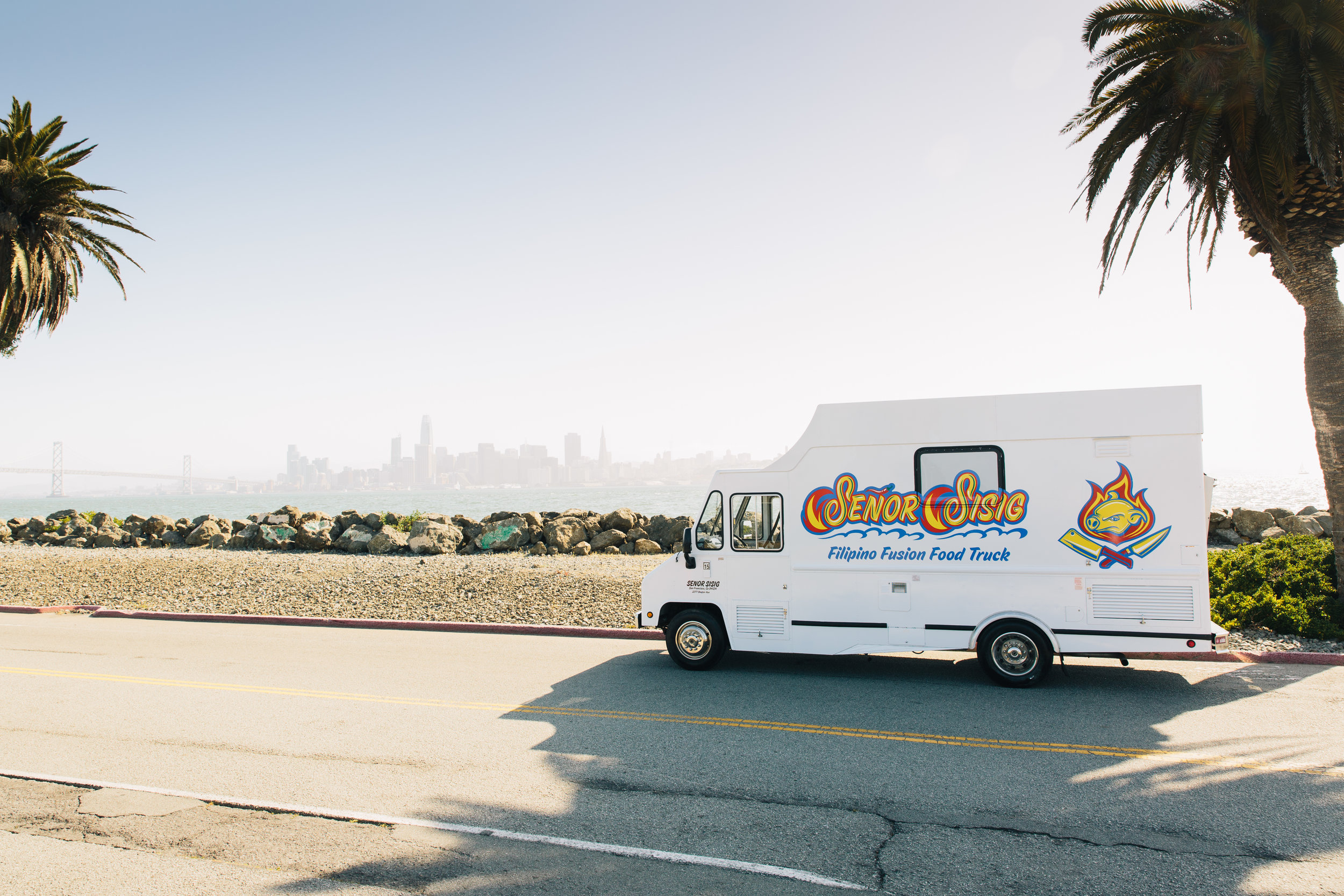
About US
In 2010, San Francisco’s street-food scene was taking baby steps, trying to walk the city’s complicated permit requirements. To make it, you needed passion and vision—exactly the two things that fueled the launch of Señor Sisig’s first food truck that year. Inspired by the success of Roy Choi’s Kogi Korean taco truck in Los Angeles, high school friends Evan Kidera, who has an MBA from San Francisco State, and Gil Payumo, an experienced chef, saw Filipino food as a Bay Area cultural force ready to break out.
With a reconditioned Chinese food truck from Modesto that Evan found on Craigslist, they were committed to the format of tacos and burritos. To fill them, they reached back in Gil’s family history to find a dish his dad was famous for at parties: sisig. In the province of Pampanga in the Philippines, where Gil’s family has roots, sisig is rustic drinking food, a highly seasoned mixture of chopped meat from the head and snout of a pig. Gil’s family recipe called instead for pork shoulder: more accessible, friendlier to modern sensibilities, and just as rich and juicy as the traditional version. Gil tweaked the recipe, which calls for infusing the pork with a highly seasoned, slightly spicy marinade for 24 hours before grilling and chopping it. He adapted the method for chicken and tofu.
He and Evan began rolling up sisig in burritos, spooning it into tacos, and sprinkling it on nachos. Driven by word of mouth on social media and the popularity of San Francisco’s newly launched Off the Grid street-food events, Señor Sisig quickly became a local phenomenon. As San Francisco and the wider Bay Area have embraced street food as a beloved form of eating, and expression of grassroots culture and the entrepreneurial spirit, Señor Sisig has grown, too.
With it’s fleet of four food trucks and three brick & mortars serving the San Francisco Bay Area you won’t have to search long to experience Señor Sisig’s truly unique take on a traditional Filipino delicacy. It’s fast, it’s fun, it’s flavorful, and best of all, it’s truly San Franciscan.
Founders
Photo by: Noah Berger
SEÑOR Evan Kidera
Evan Kidera grew up in San Francisco. As he got older, he helped out at his dads sushi restaurant, but Evan wasn’t just interested in learning how to make rainbow rolls. “I was interested in the whole process. I wanted to know both the business and the creative side of running a company,” Evan says, “I always had a passion for food and business but where I found the most value was in creating experiences for people and making them smile.”
Even though Evan’s background—via his dad—was Japanese, growing up in the city, he became immersed in Filipino culture. In high school, in 1999, Evan met one of his best friends, Gil Payumo. “Gil always had a passion for cooking. He was always in the kitchen, either helping out his parents or whipping something up for our group of friends. He was the person that really exposed me to Filipino food.”
Evan double-majored in Asian-American Studies and business at San Francisco State, where he later returned to get an MBA. By 2007, he began to wonder why San Francisco didn’t have a thriving street food scene. By 2009, when Twitter and other social media platforms were suddenly a force, Evan saw street food as a national phenomenon. “I knew it was time for SF to start its own movement,” Evan says. “And I knew the city would embrace food trucks and street food because I feel like this is the culinary melting pot of the world.” Sure that Filipino food captured something unique about the culture of San Francisco, Evan called his old friend Gil Payumo with the idea to start Señor Sisig.
Photo by: Maren Caruso
CHEF Gil Payumo
Gil Payumo was born in San Francisco and grew up in Daly City. On weekends and after school, he worked at his family’s small, neighborhood grocery store, selling phone cards and plane tickets to the Philippines, Filipino desserts and special holiday dishes. “That was a big part of my upbringing,” Gil says, “being an entrepreneur, having that work ethic.”
At parties, Gil’s father was famous for one thing: his special take on sisig. “It was labor intensive,” Gil says, “marinating the pork shoulder, and grilling it, and chopping it—I was always part of that in the kitchen with my dad.” When there were leftovers, Gil, who loved Mexican food, would make sisig quesadillas or sisig tacos.
After studying computers and realizing he had no passion for them, Gil turned to cooking—something, he says, that felt like life. He enrolled at the California Culinary Academy in San Francisco in 2003. After graduating, Gil cooked in hotels, working in restaurants kitchens, learning banquets.
But Gil felt a growing urge to start a business of his own, and when high-school buddy Evan Kidera asked if he wanted to buy a truck and be part of San Francisco’s new street food movement, Gil knew right away what he’d make: a slightly spicier version of his dad’s sisig. “Sometimes you don’t realize how the culture changes until you step back,” Gil says “As for me being Filipino, I think the movement has quadrupled through the years that Señor Sisig has been around. Filipino food—Filipino culture—is breaking barriers. It’s okay to mix another type of food, like Mexican or Korean, with Filipino. It’s okay to fuse things together, not everything has to be 100 percent traditional. These days everything is new, and food is evolving.”



